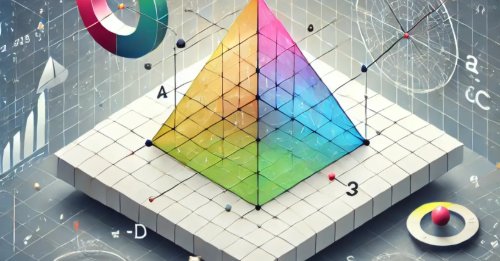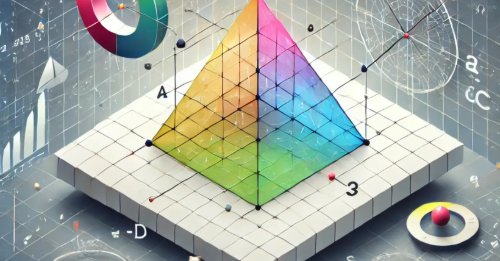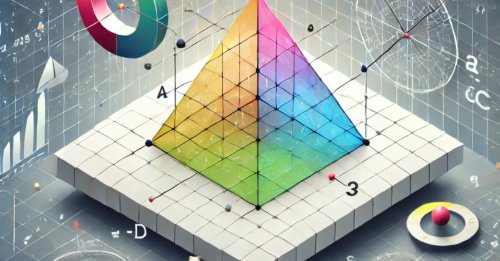[FUTA, Akure] MTS 104: Introductory Applied Mathematics
Learning Track Courses
 Vector Algebra and Foundational GeometryThis course provides a comprehensive, first-principles guide to vector analysis. We begin with the essential definitions, distinguishing between scalars, vectors, and various vector types. You will then master the core rules of vector algebra—including the triangle and parallelogram laws of addition and scalar multiplication—before applying them to prove geometric properties of polygons. The curriculum progresses logically through key concepts such as position vectors, resolving vectors into Cartesian components, the division of lines, vector projections, and the calculation of centroids.
The true power of vectors lies in their ability to connect abstract algebra to tangible geometry. This course is built around that connection, with a heavy emphasis on practical application. Through dozens of meticulously worked examples, you will move beyond theory and develop a deep, intuitive understanding of how to represent and solve complex geometric problems, building the confidence and skill needed for more advanced study.
This programme is designed for students in late secondary school (such as A-Level or IB) and first-year university students in physics, engineering, mathematics, and computer science. It is the perfect starting point for anyone new to the subject and an invaluable refresher for those who need to solidify their foundational knowledge before tackling more advanced topics like linear algebra or vector calculus.
Vector Algebra and Foundational GeometryThis course provides a comprehensive, first-principles guide to vector analysis. We begin with the essential definitions, distinguishing between scalars, vectors, and various vector types. You will then master the core rules of vector algebra—including the triangle and parallelogram laws of addition and scalar multiplication—before applying them to prove geometric properties of polygons. The curriculum progresses logically through key concepts such as position vectors, resolving vectors into Cartesian components, the division of lines, vector projections, and the calculation of centroids.
The true power of vectors lies in their ability to connect abstract algebra to tangible geometry. This course is built around that connection, with a heavy emphasis on practical application. Through dozens of meticulously worked examples, you will move beyond theory and develop a deep, intuitive understanding of how to represent and solve complex geometric problems, building the confidence and skill needed for more advanced study.
This programme is designed for students in late secondary school (such as A-Level or IB) and first-year university students in physics, engineering, mathematics, and computer science. It is the perfect starting point for anyone new to the subject and an invaluable refresher for those who need to solidify their foundational knowledge before tackling more advanced topics like linear algebra or vector calculus.
This course provides a comprehensive, first-principles guide to vector analysis. We begin with the essential definitions, distinguishing between scalars, vectors, and various vector types. You will then master the core rules of vector algebra—including the triangle and parallelogram laws of addition and scalar multiplication—before applying them to prove geometric properties of polygons. The curriculum progresses logically through key concepts such as position vectors, resolving vectors into Cartesian components, the division of lines, vector projections, and the calculation of centroids. The true power of vectors lies in their ability to connect abstract algebra to tangible geometry. This course is built around that connection, with a heavy emphasis on practical application. Through dozens of meticulously worked examples, you will move beyond theory and develop a deep, intuitive understanding of how to represent and solve complex geometric problems, building the confidence and skill needed for more advanced study. This programme is designed for students in late secondary school (such as A-Level or IB) and first-year university students in physics, engineering, mathematics, and computer science. It is the perfect starting point for anyone new to the subject and an invaluable refresher for those who need to solidify their foundational knowledge before tackling more advanced topics like linear algebra or vector calculus.
 Scalar, Vector and Triple Products of VectorsThis course delves into the essential topic of vector multiplication. We systematically explore the four main types of vector products, beginning with the scalar (dot) and vector (cross) products of two vectors. You will then advance to products involving three vectors: the scalar triple product and the vector triple product, uncovering their unique properties and applications.
Vector products are the key to unlocking the geometric power of vector analysis. They provide the tools to calculate angles, projections, areas, and volumes with elegant algebraic formulas. This course focuses on revealing these deep connections, showing how abstract multiplication rules translate into powerful methods for solving real-world problems in physics and engineering.
This is an intermediate course designed for students who have a solid grasp of foundational vector algebra and components. It is the perfect next step for students in A-Level or university STEM programmes looking to deepen their understanding of vector analysis. A strong foundation in the topics from our introductory course is highly recommended for success.
Scalar, Vector and Triple Products of VectorsThis course delves into the essential topic of vector multiplication. We systematically explore the four main types of vector products, beginning with the scalar (dot) and vector (cross) products of two vectors. You will then advance to products involving three vectors: the scalar triple product and the vector triple product, uncovering their unique properties and applications.
Vector products are the key to unlocking the geometric power of vector analysis. They provide the tools to calculate angles, projections, areas, and volumes with elegant algebraic formulas. This course focuses on revealing these deep connections, showing how abstract multiplication rules translate into powerful methods for solving real-world problems in physics and engineering.
This is an intermediate course designed for students who have a solid grasp of foundational vector algebra and components. It is the perfect next step for students in A-Level or university STEM programmes looking to deepen their understanding of vector analysis. A strong foundation in the topics from our introductory course is highly recommended for success.
This course delves into the essential topic of vector multiplication. We systematically explore the four main types of vector products, beginning with the scalar (dot) and vector (cross) products of two vectors. You will then advance to products involving three vectors: the scalar triple product and the vector triple product, uncovering their unique properties and applications. Vector products are the key to unlocking the geometric power of vector analysis. They provide the tools to calculate angles, projections, areas, and volumes with elegant algebraic formulas. This course focuses on revealing these deep connections, showing how abstract multiplication rules translate into powerful methods for solving real-world problems in physics and engineering. This is an intermediate course designed for students who have a solid grasp of foundational vector algebra and components. It is the perfect next step for students in A-Level or university STEM programmes looking to deepen their understanding of vector analysis. A strong foundation in the topics from our introductory course is highly recommended for success.
 Differentiation and Integration of Vector-Valued FunctionsThis course provides a foundational introduction to vector calculus, focusing on vector-valued functions of a single variable. You will master the rules for differentiating and integrating vectors, and learn how these operations relate to the geometry of parametric curves. The curriculum is built to give you a solid understanding of the mathematical tools that describe change in multiple dimensions.
How do we precisely describe the motion of a satellite or a particle moving along a curved path? This course answers that question by bridging the gap between abstract calculus and the real-world physics of motion. You'll learn how the elegant tools of vector differentiation and integration allow us to model velocity, acceleration, and trajectories, providing the essential language for kinematics.
This course is the essential next step for students who have a firm grasp of vector algebra and products. It is specifically designed for first-year university students in STEM fields who need to understand the calculus of vectors before tackling more advanced courses. This programme provides the critical foundation for future studies in vector mechanics, differential geometry, and the calculus of vector fields.
Differentiation and Integration of Vector-Valued FunctionsThis course provides a foundational introduction to vector calculus, focusing on vector-valued functions of a single variable. You will master the rules for differentiating and integrating vectors, and learn how these operations relate to the geometry of parametric curves. The curriculum is built to give you a solid understanding of the mathematical tools that describe change in multiple dimensions.
How do we precisely describe the motion of a satellite or a particle moving along a curved path? This course answers that question by bridging the gap between abstract calculus and the real-world physics of motion. You'll learn how the elegant tools of vector differentiation and integration allow us to model velocity, acceleration, and trajectories, providing the essential language for kinematics.
This course is the essential next step for students who have a firm grasp of vector algebra and products. It is specifically designed for first-year university students in STEM fields who need to understand the calculus of vectors before tackling more advanced courses. This programme provides the critical foundation for future studies in vector mechanics, differential geometry, and the calculus of vector fields.
This course provides a foundational introduction to vector calculus, focusing on vector-valued functions of a single variable. You will master the rules for differentiating and integrating vectors, and learn how these operations relate to the geometry of parametric curves. The curriculum is built to give you a solid understanding of the mathematical tools that describe change in multiple dimensions. How do we precisely describe the motion of a satellite or a particle moving along a curved path? This course answers that question by bridging the gap between abstract calculus and the real-world physics of motion. You'll learn how the elegant tools of vector differentiation and integration allow us to model velocity, acceleration, and trajectories, providing the essential language for kinematics. This course is the essential next step for students who have a firm grasp of vector algebra and products. It is specifically designed for first-year university students in STEM fields who need to understand the calculus of vectors before tackling more advanced courses. This programme provides the critical foundation for future studies in vector mechanics, differential geometry, and the calculus of vector fields.